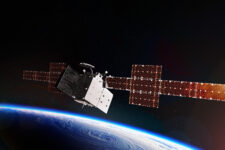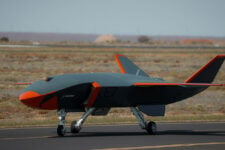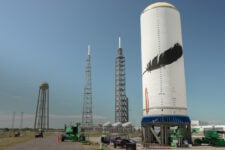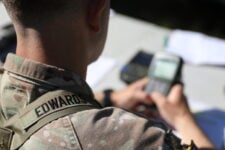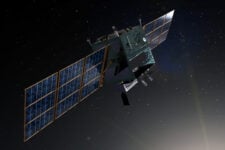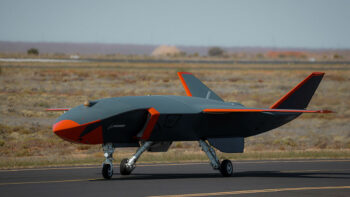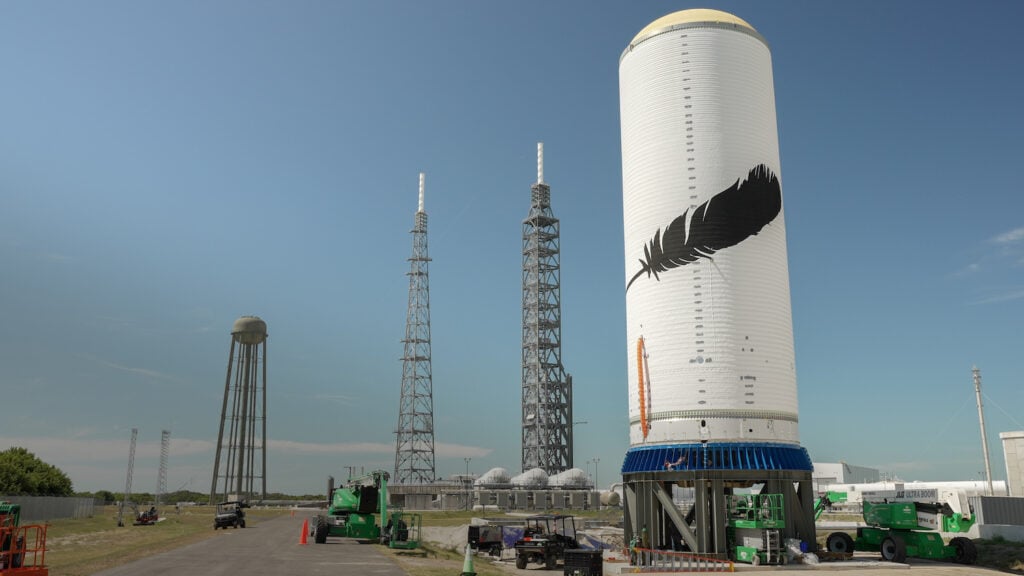
Blue Origin’s New Glenn New Glenn’s second stage tank at Launch Complex 36 in Cape Canaveral, FL., July 14, 2022. (Photo: Blue Origin)
GEOINT 2024 — Rather than fixating on large constellations of small satellites, the National Reconnaissance Office (NRO) should be looking to build satellites even bigger and more capable of pinpointing targets than today’s intelligence, surveillance and reconnaissance birds to stay ahead of China and Russia, according to a new report.
“The NRO should accelerate development of much larger ISR satellites for electro-optical, radar, and signals intelligence missions specifically designed for super-heavy launch vehicles. The exquisite intelligence and unparalleled indications and warnings such systems can provide would create a distinct advantage in the competition phase to bolster deterrence,” finds the report titled “Building an Enduring Advantage in the Third Space Age” and released today by the American Enterprise Institute.
“Russia and China will likely not be able to launch payloads with these dimensions for many years,” the report adds.
Todd Harrison, the report’s author and a veteran military space analyst, acknowledged in an email that this recommendation bucks the tidal wave of interest, including at NRO and the Space Force, in creating more resilient space architectures by utilizing mega-constellations of smaller satellites.
“Yes, I am swimming in a different direction on this recommendation for sure. But to be clear it’s not a recommendation to go bigger instead of proliferating with smaller satellites — it’s a recommendation to do both. The super-sized ISR satellites I am talking about would be used to provide indications and warnings in the competition phase through the crisis phase,” he explained.
The US military has traditionally relied upon large, exquisite satellites in years past, but that thinking has come under fire as the potential for adversaries to attack those single-point-of-failure platforms has increased.
“In conflict, they absolutely become big juicy targets, and that’s where we would rely on the smaller, highly proliferated architectures. But the value of the big, exquisite systems is to help prevent competition from tipping into conflict,” Harrison added.
Further, he argues, even though bigger, badder ISR satellites would be expensive, the NRO would not require many of them.
“In terms of cost, you don’t need to proliferate an exquisite capability like this — a small number of superheavy ISR satellites would suffice. These systems should not be designed for a high level of resilience or protection — they are essentially a tripwire,” Harrison said.
The critical aspect, he stressed, is for the spy-sat agency to get moving on development of these new types of satellites as soon as possible to take advantage of the fact that the US is in the lead in developing super-heavy lift rockets, such as SpaceX’s Starship and Blue Origin’s New Glenn.
“We needed to start building ISR satellites to take advantage of these super-heavy vehicles years ago to be ready to launch within the next year, so the least we could do is get started now so we have satellites ready before Starship and New Glenn are nearing retirement,” Harrison said, in a poke at the US government’s traditional 10-to-15-year timeline for building new satellites.
Meanwhile, the report says, the Space Force should be in charge of pursuing large networks of small satellites under the Space Development Agency’s Proliferated Warfighter Space Architecture (PWSA) — differentiating its “tactical ISR” job from the “strategic” mission of NRO. Harrison’s recommendation thus directly wades into the ongoing turf battle between the Space Force, NRO and the National Geospatial-Intelligence Agency over ISR satellite operations.
“The Space Force should double down on the PWSA by starting development of a new layer for tactical ISR that is optimized to detect, track, and maintain custody of targets in a highly contested battle space,” the report finds.
“The service has negotiated with the NRO for too long over how to do this through a joint acquisition strategy, and after years of discussion, its program for a Ground Moving Target Indication capability in space is only just now reaching Milestone B (the point at which an acquisition program formally begins). It is time for the Space Force to move ahead independently of the NRO to develop a tactical ISR capability that is owned and operated by the Space Force,” it adds.
In addition to moving out more rapidly on proliferated ISR capabilities, the report recommends that the Space Force “accelerate efforts in the emerging areas of space logistics and in-space servicing of satellites,” including putting a five-year line item in its next budget request. Efforts up to now, the report argues, “are merely dipping a toe in the waters of what stands to be a breakthrough capability for the US intelligence community and military, even more so than aerial refueling was for the US Air Force.”
The service also should pick up the pace on developing a capability for “rapid delivery of cargo and personnel via launch vehicles on a suborbital trajectory. While spacelift is a niche capability due to payload capacity and cost constraints, it could be highly advantageous in some scenarios and a disruptive factor for adversary war plans and operational concepts, making it one of the Space Force’s most promising new mission areas.”
The Space Force has been experimenting, primarily via the Air Force Research Laboratory’s Rocket Cargo Vanguard program, with such a capability, and in its fiscal 2025 budget request for the first time asked for funds to make what it now calls Point-to-Point Delivery (P2PD) a new-start research and development program. However, Harrison’s report argues more should be done faster, including new experiments “with spacelift cargo delivery at sea using uncrewed ships as landing pads.”


